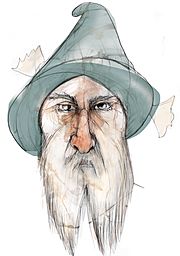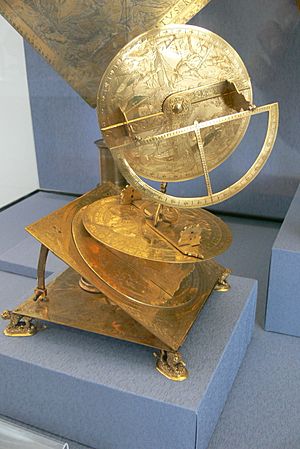Jabir ibn Aflah facts for kids
Quick facts for kids
Jābir ibn Aflaḥ
|
|
|---|---|

Fictional portrait by Eulogia Merle for the Fundación Española para la Ciencia y la Tecnología (2011)
|
|
| Born | 1100 CE |
| Died | 1150 CE |
| Academic work | |
| Era | Islamic Golden Age |
| Main interests | Astronomy, Mathematics |
| Notable works | Iṣlāḥ al-Majisṭi (Correction of the Almagest) |
| Notable ideas |
|
| Influenced | Averroes, Nur ad-Din al-Betrugi |
Abū Muḥammad Jābir ibn Aflaḥ (Arabic: أبو محمد جابر بن أفلح, Latin: Geber/Gebir) was a brilliant Arab Muslim scholar. He lived in Seville, a city in al-Andalus (modern-day Spain), from about 1100 to 1150 CE.
Jābir was an expert in both astronomy (the study of stars and planets) and mathematics. His most famous book was called Iṣlāḥ al-Majisṭi, which means 'Correction of the Almagest'. This important work influenced many Islamic, Jewish, and Christian astronomers for centuries.
Contents
His Book: Iṣlāḥ al-Majisṭi
Jābir's book, Iṣlāḥ al-Majisṭi, was a detailed review of an older, very famous astronomy book. This older book was called the Almagest and was written by Ptolemy. Ptolemy was an ancient Greek astronomer.
Jābir was the first scholar in the Islamic West to criticize Ptolemy's work. He especially looked at the math parts of the Almagest.
Improving Ptolemy's Math
Jābir wanted to make the math in Ptolemy's book more exact. He used new methods based on spherical trigonometry. This is a special type of math used to calculate distances and angles on the surface of a sphere, like Earth or other planets.
These new math ideas had been developed by other Islamic mathematicians. Jābir used these advanced methods to improve the calculations in astronomy.
Changing Planet Positions
One big change Jābir made was about the planets Venus and Mercury. In Ptolemy's original book, these planets were placed between the Moon and the Sun.
Jābir, however, believed that Venus and Mercury orbited outside the Sun. This was a different idea for his time.
Amazing Inventions
Jābir ibn Aflaḥ was also an inventor! He created a special tool called the torquetum.
What is a Torquetum?
The torquetum was a mechanical device. It helped astronomers change between different ways of measuring positions in space. Imagine trying to find a star's exact spot. The torquetum made it easier to switch between different coordinate systems. This made it a very useful tool for observing the sky.
His Lasting Influence
Jābir's work had a big impact on many later scholars.
Influence in the Islamic World
Many Muslim thinkers were influenced by Jābir. These included famous scholars like Ibn Rushd (also known as Averroes) and Nur ad-Din al-Betrugi. Both of them also worked in al-Andalus.
Jābir's book traveled far. It reached Egypt in the 1100s and other eastern lands by the late 1200s.
Influence in Europe
Jābir's book was translated from Arabic into Hebrew and Latin. The Latin translation was done by a scholar named Gerard of Cremona. He gave Jābir the Latin name "Geber."
Through this Latin translation, Jābir's ideas spread widely across Europe. His work helped to make trigonometry more popular in Europe. This was very important for the future of mathematics and astronomy.
For example, a lot of the information about spherical trigonometry in a famous European book, On Triangles (written around 1463 by Regiomontanus), came directly from Jābir's work. This was later noted by another scholar, Gerolamo Cardano, in the 1500s.
See also
 In Spanish: Jabir ibn Aflah para niños
In Spanish: Jabir ibn Aflah para niños


